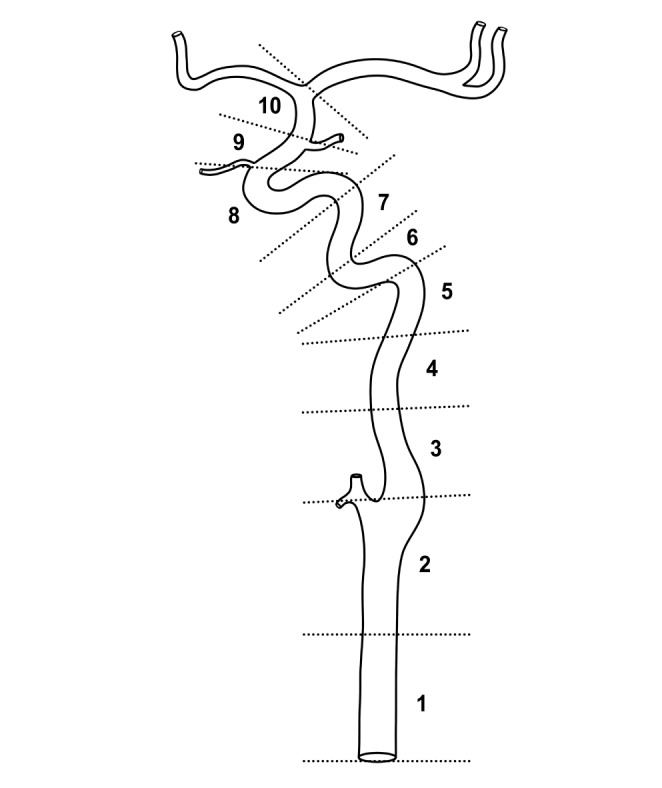Neurointervention.
2017 Sep;12(2):91-99. 10.5469/neuroint.2017.12.2.91.
Optimal Guiding Catheter Length for Endovascular Coiling of Intracranial Aneurysms in Anterior Circulation in Era of Flourishing Distal Access System
- Affiliations
-
- 1Department of Radiology and Research Institute of Radiology, Asan Medical Center, Seoul, Korea. dhlee@amc.seoul.kr
- 2Department of Radiology, The First Affiliated Hospital of Nanjing Medical University, Nanjing, China.
- 3Department of Neurology, Korea University Ansan Hospital, Korea University College of Medicine, Ansan, Korea.
- KMID: 2389501
- DOI: http://doi.org/10.5469/neuroint.2017.12.2.91
Abstract
- PURPOSE
To determine the minimum required guiding catheter length for embolization of various intracranial aneurysms in anterior circulation and to analyze the effect of various patient factors on the required catheter length and potential interaction with its stability.
MATERIALS AND METHODS
From December 2016 to March 2017, 90 patients with 93 anterior circulation aneurysms were enrolled. Three types of guiding catheters (Envoy, Envoy DA, and Envoy DA XB; Codman Neurovascular, Raynham, MA, USA) were used. We measured the in-the-body length of the catheter and checked the catheter tip location in the carotid artery. We analyzed factors affecting the in-the-body length and stability of the guiding catheter system.
RESULTS
The average (±standard deviation) in-the-body length of the catheter was 84.2±5.9 cm. The length was significantly longer in men (89.1±5.6 vs. 82.1±4.6 cm, P<0.001), patients older than 65 years (87.7±7.8 vs. 82.7±4.2 cm, P<0.001), patients with a more tortuous arch (arch type 2 and 3) (87.5±7.4 vs. 82.7±4.4 cm, P<0.001), and patients with a distal aneurysm location (distal group) (86.2±5.0 vs. 82.7±6.1 cm, P=0.004). A shift in the tip location was noted in 19 patients (20.4%); there was no significant different among the 3 catheters (P=0.942).
CONCLUSION
The minimum required length of a guiding catheter was 84 cm on average for elective anterior-circulation aneurysm embolization. The length increased in men older than 65 years with a more tortuous arch. We could reach a higher position with distal access catheters with little difference in the stability once we reached the target location.
Keyword
Figure
Reference
-
1. Kalia JS, Zaidat OO. Using a distal access catheter in acute stroke intervention with penumbra, merci and gateway. A technical case report. Interv Neuroradiol. 2009; 15:421–424. PMID: 20465880.2. Velat GJ, Lawson MF, Hoh BL, Mocco J. Novel application of an intermediate sized bridging catheter as an adjunct to aneurysm coiling in patients with tortuous vasculature. Interv Neuroradiol. 2009; 15:448–452. PMID: 20465884.
Article3. Hui FK, Schuette AJ, Spiotta AM, Yim J, Obuchowski N, Rasmussen PA, et al. Flexible tip guides and intermediate catheters: two center experience and a proposed taxonomy. J Neurointerv Surg. 2014; 6:618–623. PMID: 24014468.
Article4. Hauck EF, Tawk RG, Karter NS, Binning MJ, Khalessi AA, Natarajan SK, et al. Use of the outreach distal access catheter as an intracranial platform facilitates coil embolization of select intracranial aneurysms: technical note. J Neurointerv Surg. 2011; 3:172–176. PMID: 21990813.
Article5. Spiotta AM, Hussain MS, Sivapatham T, Bain M, Gupta R, Moskowitz SI, et al. The versatile distal access catheter: the Cleveland Clinic experience. Neurosurgery. 2011; 68:1677–1686. discussion 86. PMID: 21311375.
Article6. Binning MJ, Yashar P, Orion D, Hauck EF, Levy EI, Hopkins LN, et al. Use of the Outreach Distal Access Catheter for microcatheter stabilization during intracranial arteriovenous malformation embolization. AJNR Am J Neuroradiol. 2012; 33:E117–E119. PMID: 21757517.
Article7. Lin LM, Colby GP, Huang J, Tamargo RJ, Coon AL. Ultra-distal large-bore intracranial access using the hyperflexible Navien distal intracranial catheter for the treatment of cerebrovascular pathologies: a technical note. J Neurointerv Surg. 2014; 6:301–307. PMID: 23729497.
Article8. Wang D, Wang Y, Su W, Wang Y, Li G, Li X. A novel approach using Neuron 6F guiding catheter for the embolization of intracranial aneurysm with coiling of the parent internal carotid artery. Int J Clin Exp Med. 2015; 8:1534–1539. PMID: 25785169.9. Colby GP, Lin LM, Xu R, Beaty N, Bender MT, Jiang B, et al. Utilization of a Novel, Multi-Durometer Intracranial Distal Access Catheter: Nuances and Experience in 110 Consecutive Cases of Aneurysm Flow Diversion. Interv Neurol. 2017; 6:90–104. PMID: 28611839.
Article10. Lam RC, Lin SC, DeRubertis B, Hynecek R, Kent KC, Faries PL. The impact of increasing age on anatomic factors affecting carotid angioplasty and stenting. J Vasc Surg. 2007; 45:875–880. PMID: 17466784.
Article11. Burzotta F, Nerla R, Pirozzolo G, Aurigemma C, Niccoli G, Leone AM, et al. Clinical and procedural impact of aortic arch anatomic variants in carotid stenting procedures. Catheter Cardiovasc Interv. 2015; 86:480–489. PMID: 25846903.
Article12. Puri AS, Kuhn AL, Hou SY, Wakhloo AK. Use of intermediate guide catheters as an adjunct in extracranial embolization to avoid onyx reflux into the anastomotic vasculature. A technical note. Interv Neuroradiol. 2014; 20:424–427. PMID: 25207904.13. Lee HC, Kang DH, Hwang YH, Kim YS, Kim YW. Forced Arterial Suction Thrombectomy Using Distal Access Catheter in Acute Ischemic Stroke. Neurointervention. 2017; 12:45–49. PMID: 28316869.
Article14. Shallwani H, Shakir HJ, Rangel-Castilla L, Davies JM, Sonig A, Sattur MG, et al. Safety and Efficacy of the Sofia (6F) PLUS Distal Access Reperfusion Catheter in the Endovascular Treatment of Acute Ischemic Stroke. Neurosurgery. 2017.
Article15. Stampfl S, Kabbasch C, Muller M, Mpotsaris A, Brockmann M, Liebig T, et al. Initial experience with a new distal intermediate and aspiration catheter in the treatment of acute ischemic stroke: clinical safety and efficacy. J Neurointerv Surg. 2016; 8:714–718. PMID: 26024865.
Article16. Wong JH, Do HM, Telischak NA, Moraff AM, Dodd RL, Marks MP, et al. Initial experience with SOFIA as an intermediate catheter in mechanical thrombectomy for acute ischemic stroke. J Neurointerv Surg. 2016.
Article
- Full Text Links
- Actions
-
Cited
- CITED
-
- Close
- Share
- Similar articles
-
- Advantages and disadvantages of the ENVOY 6F distal access guiding catheter in endovascular coiling for anterior circulation aneurysms
- Seven Intracranial Aneurysms in One Patient: Treatment and Review of Literature
- Endovascular treatment of intracranial aneurysms: Past and present
- Comprehension of Two Modalities: Endovascular Coiling and Microsurgical Clipping in Treatment of Intracranial Aneurysms
- Current Update on the Randomized Controlled Trials of Intracranial Aneurysms


